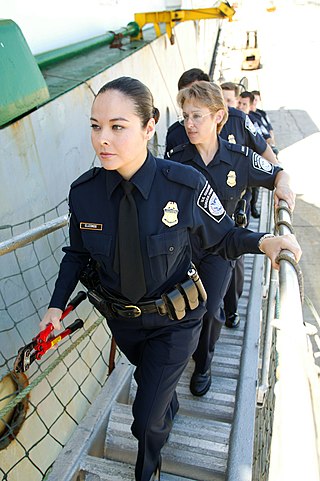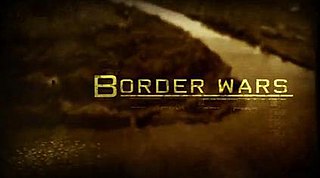
A coast guard or coastguard is a maritime security organization of a particular country. The term embraces wide range of responsibilities in different countries, from being a heavily armed military force with customs and security duties to being a volunteer organization tasked with search and rescue without law enforcement authority. In most countries, a typical coast guard's functions are distinct from those of the navy and the transit police, while in certain countries they have similarities to both.
U.S. Immigration and Customs Enforcement (ICE) is a federal law enforcement agency under the U.S. Department of Homeland Security. ICE's stated mission is to protect the United States from the cross-border crime and illegal immigration that threaten national security and public safety.

The United States Border Patrol (USBP) is a federal law enforcement agency under the United States Customs and Border Protection (CBP) and is responsible for securing the borders of the United States. According to its web site in 2022, its mission is to "Protect the American people, safeguard our borders, and enhance the nation’s economic prosperity."

The United States Customs Service was a federal law enforcement agency of the U.S. federal government. Established on July 31, 1789, it collected import tariffs, performed other selected border security duties, as well as conducted criminal investigations.

United States Customs and Border Protection (CBP) is the largest federal law enforcement agency of the United States Department of Homeland Security. It is the country's primary border control organization, charged with regulating and facilitating international trade, collecting import duties, as well as enforcing U.S. regulations, including trade, customs and immigration. CBP is one of the largest law enforcement agencies in the United States. It has a workforce of more than 45,600 federal agents and officers. It is headquartered in Washington, D.C.

Police aviation is the use of aircraft in police operations. Police services commonly use aircraft for traffic control, ground support, search and rescue, high-speed car pursuits, observation, air patrol and control of large-scale public events and/or public order incidents. They may employ rotary-wing aircraft, fixed-wing aircraft, nonrigid-wing aircraft or lighter-than-air aircraft. In some major cities, police rotary-wing aircraft are also used as air transportation for personnel belonging to SWAT-style units. In large, sparsely populated areas, fixed-wing aircraft are sometimes used to transport personnel and equipment.

A border guard of a country is a national security agency that performs border security. Some of the national border guard agencies also perform coast guard and rescue service duties.

The Border Patrol Tactical Unit (BORTAC) is the tactical unit of the United States Border Patrol. In 2007, BORTAC was placed under the command of the newly formed Special Operations Group (SOG) together with the Border Patrol Search, Trauma, and Rescue Unit (BORSTAR).

Operation Jump Start was a military operation to aid U.S. Customs and Border Protection, announced by President George W. Bush in May 2006. The mission entailed the deployment of United States National Guard troops along the Mexico–United States border for purposes of enforcement of border security and construction of a border fence. The rules of deployment were defined in a memorandum of agreement between officials in the Department of Defense and the governors of Arizona, California, New Mexico, and Texas as well as Mexico.
The United States Coast Guard is the coastal defense, search and rescue, and maritime law enforcement branch of the United States Armed Forces and is one of the country's eight uniformed services. It carries out three basic roles, which are further subdivided into eleven statutory missions. The three roles are:

USCGC Tampa (WMEC-902) is a United States Coast Guard medium endurance cutter. She was commissioned 16 March 1984. Her motto, "Thy way is the sea, thy path in the great waters", matches the inscription that is engraved on the memorial at Arlington National Cemetery for the 131 persons lost following the sinking of a previous cutter Tampa on September 18, 1918.
SBInet, the Secure Border Initiative Network, was a program initiated in 2006 for a new integrated system of personnel, infrastructure, technology, and rapid response to secure the northern and southern land borders of the United States. It was a part of Secure Border Initiative (SBI), an overarching program of the United States Department of Homeland Security (DHS) to organize the four operating components of border security: U.S. Customs and Border Protection (CBP), U.S. Immigration and Customs Enforcement, United States Citizenship and Immigration Services, and the United States Coast Guard. DHS announced the program's cancellation on Jan. 14, 2011.

The federal government of the United States empowers a wide range of federal law enforcement agencies to maintain law and public order related to matters affecting the country as a whole.

Coast Guard Air Station Borinquen is a United States Coast Guard Air Station located at the Rafael Hernandez International Airport, in Aguadilla, Puerto Rico.

The Deployable Specialized Forces (DSF) —formerly Deployable Operations Group— are part of the United States Coast Guard that provide highly equipped, trained and organized deployable specialized forces, to the Coast Guard, United States Department of Homeland Security (DHS), United States Department of Defense (DoD) and inter-agency operational and tactical commanders. The command was formerly headquartered in Arlington, Virginia where it was established on 20 July 2007, and was commanded by a captain. It was decommissioned by the Commandant of the Coast Guard, Admiral Robert Papp on 1 October 2013, with units previously assigned to the DOG being split between Coast Guard Pacific and Atlantic Area commands. The units were subsequently reorganized under Deployable Specialized Forces (DSF).

The Puerto Rico Joint Forces of Rapid Action —Spanish: Fuerzas Unidas de Rapida Acción (FURA)— is an agency within the Puerto Rico Police in charge of specialized divisions that relate to federal law enforcement agencies of the United States, and coordinate operations between the PRPD and U.S. federal agencies. The force is a limited unit, well trained, and well recognized in the police. The force collaborates with law enforcement agencies of the federal government of the United States such as the Federal Bureau of Investigation, the Bureau of Alcohol, Tobacco, Firearms and Explosives, the United States Marshals Service, and the Department of Homeland Security among others.
Airbus Group, Inc. represents the North American activities of European multinational aerospace company Airbus. Headquartered in Herndon, Virginia, this American arm of the company participates in U.S. Department of Defense programs, in some cases as a prime contractor. The American unit operates under a Special Security Arrangement which allows it to work independently on some of the most sensitive United States defense programs despite its foreign ownership. It employs approximately 3,200 people and had 2011 revenues of $1.3 billion.

Border Wars is an American documentary television series on the National Geographic Channel. The program follows agents of the U.S. Border Patrol (USBP), U.S. Customs and Border Protection (CBP), Immigration and Customs Enforcement (ICE), and other divisions of the Department of Homeland Security as they investigate and apprehend illegal immigrants, drug smugglers, and other criminals violating immigration laws. The series follows Air Interdiction Agents and Marine Interdiction Agents who patrol along the U.S.-Mexico border, as well as southern Florida and Puerto Rico.

Randolph D. "Tex" Alles is an American law enforcement officer and government official who currently serves as the Deputy Under Secretary of Homeland Security for Management and the de facto head of the DHS Management Directorate, under the various titles of both Acting Under Secretary and Senior Official Performing the Duties of Under Secretary. He also served as the 25th Director of the United States Secret Service from April 2017 to May 2019, and previously as the acting deputy commissioner of U.S. Customs and Border Protection, as well as in the United States Marine Corps, in which he reached the rank of major general.



























